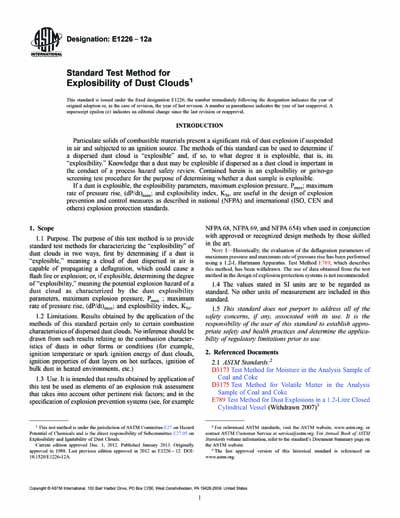Historical
ASTM E1226-12a
Standard Test Method for Explosibility of Dust Clouds
1.1 Purpose. The purpose of this test method is to provide standard test methods for characterizing the “explosibility” of dust clouds in two ways, first by determining if a dust is “explosible,” meaning a cloud of dust dispersed in air is capable of propagating a deflagration, which could cause a flash fire or explosion; or, if explosible, determining the degree of “explosibility,” meaning the potential explosion hazard of a dust cloud as characterized by the dust explosibility parameters, maximum explosion pressure, Pmax ; maximum rate of pressure rise, (dP/dt)max; and explosibility index, KSt.
1.2 Limitations. Results obtained by the application of the methods of this standard pertain only to certain combustion characteristics of dispersed dust clouds. No inference should be drawn from such results relating to the combustion characteristics of dusts in other forms or conditions (for example, ignition temperature or spark ignition energy of dust clouds, ignition properties of dust layers on hot surfaces, ignition of bulk dust in heated environments, etc.)
1.3 Use. It is intended that results obtained by application of this test be used as elements of an explosion risk assessment that takes into account other pertinent risk factors; and in the specification of explosion prevention systems (see, for example NFPA 68, NFPA 69, and NFPA 654) when used in conjunction with approved or recognized design methods by those skilled in the art.
1.4 The values stated in SI units are to be regarded as standard. No other units of measurement are included in this standard.
1.5 This standard does not purport to address all of the safety concerns, if any, associated with its use. It is the responsibility of the user of this standard to establish appropriate safety and health practices and determine the applicability of regulatory limitations prior to use.
Content Provider
ASTM International [astm]






